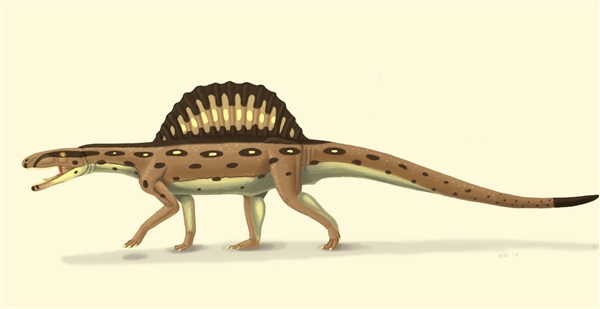
The study represents the latest chapter in a long-running debate over the relationships between dinosaurs and the ancestors of two dissimilar types of modern-day creatures - crocs and birds.
Paleontologists have traced the ancestry of all three groups to a category of common ancestors called archosaurs. The archosaurs and their cousins lived around the time of Earth's deadliest die-off, the Permian-Triassic extinction, around 252 million years ago. Teasing out the details of the archosaurs' family tree is key to understanding how birds, dinosaurs and crocodiles are linked.
"This is one of the most interesting evolutionary questions in paleontology: the origin of birds in the broadest sense," Spencer G. Lucas, curator of paleontology at the New Mexico Museum of Natural History, told me today. "If you take crocodiles, birds and dinosaurs, how do you think that evolutionary tree came together?"
Most experts say birds could actually be considered the modern-day descendants of dinosaurs, while a relative few insist that dinosaurs were more closely related to crocodiles.
Second look at fossils from China
The new analysis, published on Tuesday in Earth and Environmental Science Transactions of the Royal Society of Edinburgh, focuses on the fossilized remains of a creature unearthed in China, known as Xilousuchus sapingensis. The specimen, consisting of a partial skull and 10 neck vertebrae, has been dated to the Early Triassic (252 million to 247 million years ago).
Xilousuchus was originally classified as a distant offshoot of the archosaur tree, known as Proterosuchia, and was thus thought to shed little light on the bird-croc-dino relationship. But the revised analysis puts it closer to the center of the archosaur family tree, and tending toward the crocodile side of an evolutionary split. Birds and dinosaurs would be on the other side of that split, said Sterling Nesbitt, a postdoctoral researcher at the University of Washington who led the research team.
The technique that was used for the analysis involved making detailed measurements of features in the fossilized bones. For example, if a fossilized specimen shows the hallmarks of a wing, that could lead scientists to classify the fossil as belonging to a bird.
"We used the same kind of reasoning for all the little features on the bones where the muscles attach, and we score it into this computer program and it tells us how these creatures are related," Nesbitt explained. "Once you put it into this context, it all falls together. ... Xilousuchus is our oldest evidence of an archosaur in the fossil record."
What it all means ... or maybe not
The fact that the main group of archosaurs showed signs of divergence so soon after the Permian-Triassic extinction suggested to Nesbitt and his colleagues that there might be a linkage. "It could have been that the Permian extinction triggered the rise of archosaurs because they filled a niche that was emptied by the extinction," he told me. "This is one possibility that we're looking into now."
Just as the demise of the dinosaurs led to the rise of mammals 65 million years ago, the earlier mass extinction may have contributed to the rise of the dinosaurs 250 million years ago, Nesbitt said.
At the New Mexico museum, Lucas said he wasn't sure the case was that clear-cut. There are so few specimens from the Permian-Triassic transition that the criteria for classification are still subject to debate, and it would be easy to make too much out of the fine distinctions between one fossil and another. "Some of this is merely semantics," he said.
"This is an interesting idea," he told me, "but I await the next analysis of the evolutionary relationship. All of this is really in flux."
Update for 10 p.m. ET: I heard back via email from Thomas Holtz, a paleontologist at the University of Maryland and author of "Dinosaurs," a dino-encyclopedia. Here's what he had to say:
"Although I haven't read the paper yet, the conclusions seem sound. That is, Nesbitt and his colleagues have closely re-examined a lot of the Triassic archosaurs and other archosauriforms (what we used to call 'thecodonts' in the old days, until it was recognized that 'thecodonts' just meant 'any poor archosauriform unlucky enough not to be a crocodilian, pterosaur, or dinosaur'), and have the biggest phylogenetic analyses of these guys out there.
"Xilosuchus falls out as a member of the poposauroids in their studies, an odd assemblage of croc-relatives (some look a lot like finned proto-mammals like Dimetrodon; others look superficially like dinosaurs).
"Because it is a poposauroid, that means that the common ancestor of all poposauroids, and of all pseudosuchians (all archosaurs closer to crocodilians than to birds) must have already been present. And if Pseudosuchia is present, its sister group Avemetatarsalia (birds and everything closer to birds) has to be present in at least its most primitive state.
"Now the avemetatarsalians at this time wouldn't be birds, or theropods, or even dinosaurs. In fact, Avemetatarsalia probably had not yet split into Pterosauromorpha and Dinosauromorpha. But it does mean that the lineages which would ultimate lead to alligators on one side and eagles on the other had already diverged in the earliest days of the Triassic."



Reader Comments
to our Newsletter